Last-Minute NYC Holiday Gift Guide 🎁
We’ve created a holiday gift guide with presents for the intrepid New Yorker that should arrive just in time—


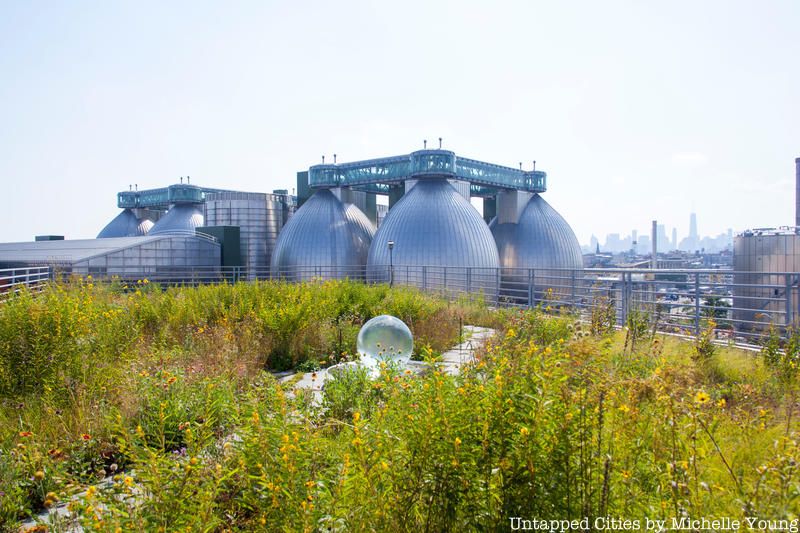
Untapped Cities founder Michelle Young and CEO Augustin Pasquet (who moonlights as a photographer when called) are the authors of the guide book Secret Brooklyn: An Unusual Guide. The second edition of the book has just been released officially today, and now following launch events at the Montauk Club and Kingsland Wildflowers, they’re sharing five of their favorite new locations.
Read on for an excerpt of each of these secret, hidden, or lesser-known locations! You can get an autographed copy directly from Untapped Cities (shipped to you or picked up from our Brooklyn office) or a non-autographed copy on Amazon.
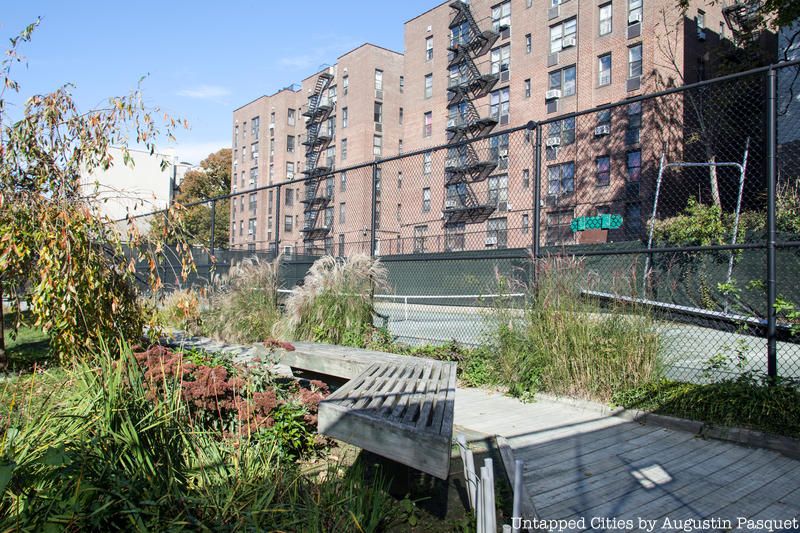
Originally, Michelle and Augustin were interested in doing an entry on the “punny” street name, “Tennis Court” in Flatbush. This led them to discover that at the end of Tennis Court is a genuine, hidden tennis club!
Nothing celebratory denotes the existence of the Knickerbocker Field Club, a historic tennis club along the street, beyond a small green sign atop a roll-down gate entrance. But walk through the parking lot and make a left, and you’ll discover five original clay courts in pristine condition that date to the founding of the club in 1889. The Knickerbocker Field Club was part of a land lease from Ronald Ficken, a developer who pioneered the real-estate development in the Flatbush area in the mid-1880s. The secret tennis club is the only remnant of the Tennis Court development, which originally spanned several square blocks.
The club was wildly successful from its inception, attracting prominent Brooklyn families as members with many women from the beginning. Today, there are 170 members with over 100 people on the waitlist. According to the club officers, it takes up to ten years to get a membership, at $900 per season. Although most members are from the surrounding Brooklyn area, there are members from Manhattan and Queens (and Staten Island in the past).
On a visit, when asked why people come from a distance to play here, one of the members impromptu called out “Because it’s the best!” Another member, Beth Moorsmith, says, “It’s partly the history, because this place has been around for so long. And it’s partly that it’s so New York.” Her husband Reid adds, “There are no fancy pretensions. People like to play tennis. Despite the fact that it’s surrounded by brick buildings and a subway, it feels like an oasis.”
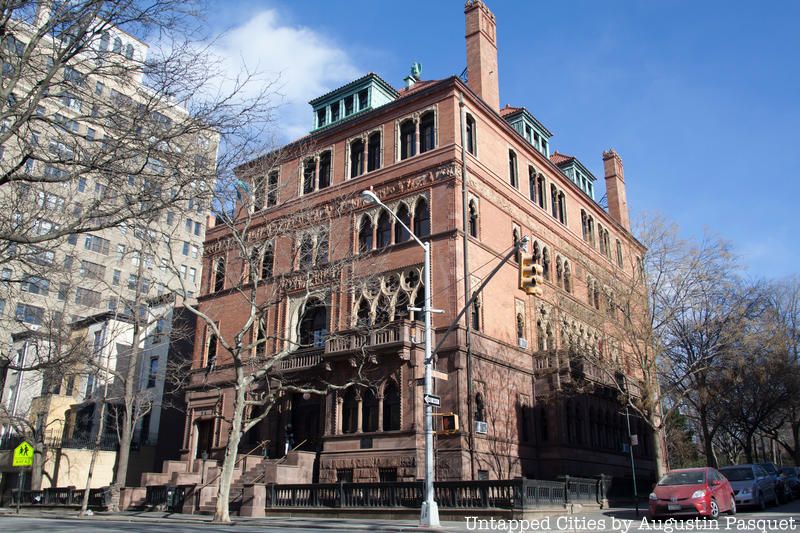
On the corner of Eighth Avenue and Lincoln Place in Park Slope, just off Grand Army Plaza, is the Montauk Club, a Venetian Gothic palazzo-inspired private club built in 1891. The interiors, though only open to the public on rare occasions, are often seen in film and on television in shows like Billions, Boardwalk Empire and The Knick. Some of the notable people who have stepped through these doors include four United States Presidents – John F. Kennedy, Dwight D. Eisenhower, Grover Cleveland, and William McKinley – who gave speeches.
The Montauk Club was founded in 1888, in the tradition of private clubs at the height of the Gilded Age. It was designed by Frances H. Kimball, a notable architect whose famous buildings still stand in New York City today – including the Trinity and U.S. Realty Buildings on Broadway, the Corbin Building next to Fulton Center, and the Emmanuel Baptist Church in Clinton Hill, Brooklyn. The exterior design of the Montauk Club was inspired by the Ca d’Oro, also known as the Palazzo Santa Sofia, on the Grand Canal in Venice.
But look closely and you will see references to the Montauk Indians on much of the building’s exterior: terra cotta faces peer out from atop columns and above the main entrance, while a wraparound frieze between the third and fourth floors features scenes related to the Indian tribe. The cast iron fence that wraps around the building also shows Indian faces. In 2004, Chief Robert Pharoah, representing the tribe, was a guest at the 115th Anniversary Celebration of the club.
On a visit inside, don’t miss the balcony off the dining room which has more Indian faces and a lovely view of Prospect Park.
You can get an autographed copy directly from Untapped Cities shipped to you or picked up from our Brooklyn office!
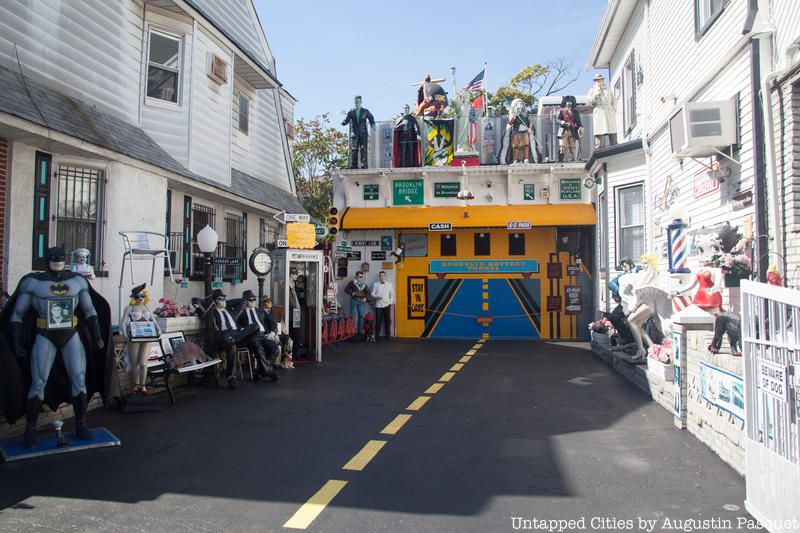
In all of New York City, there’s nothing quite like the Bensonhurst Statue House. Located halfway down 85th Street between 20th and 21st avenues, number 2056 would be fairly non-descript were it not for the nearly forty life-size sculptures of pop culture figures that stand guard. Superman flies out from a second story balcony, Batman keeps watch at the foot of the driveway, Marilyn Monroe and Elvis flirt and and croon, James Dean looks over at Humphrey Bogart, Betty Boop eyes an unseen interloper, Dracula and Frankenstein look forebodingly from above the garage. The tableau is replete with kitchy accoutrements ranging from an old-school phone booth, street signs, lamppost, and other memorabilia from the mid-century.
The whole creation is the work of Steve Campanella, a retired Marine who uses the spectacle to express his love of the pop culture from his childhood and his deep pride in his hometown of Brooklyn. Memory Lane, reads one sign attached to a lamppost. The driveway and garage are fashioned like the approach to the Brooklyn Battery Tunnel, with two “lanes” where you can choose Cash or EZ-Pass. Many of the signs are about Brooklyn, including one that points to Ebbets Field. Steve’s Playland, Campanella calls it, and even more can be found inside his massive garage where thousands of collector items are stored.
You can get an autographed copy directly from Untapped Cities shipped to you or picked up from our Brooklyn office!

Kingsland Wildflowers has a spectacular view of the Newtown Creek Digester Eggs
At the northeastern tip of Greenpoint, the former facilities of Standard Oil once encompassed fifty acres of former marshland along Newtown Creek.Several decades of mishandling resulted in a century of accumulated oil contamination and a fire in 1919 caused a loss of 110 million gallons of oil. But amidst the foreboding landscape of the Greenpoint oil spill zone, glimpses of nature can be found.
One such place is Kingsland Wildflowers, a lush series of green roofs hidden atop Broadway Stages, one of the largest television and film production companies in New York City. Funded predominantly by the Greenpoint Community Environmental Fund, a grant program created from an ExxonMobil settlement, and Broadway Stages, Kingsland Wildflowers was conceived by Marni Marjorelle, the owner and founder of Alive Structures green roofing company, in partnership with NYC Audubon and Newtown Creek Alliance. In addition to monitoring wildlife populations on the green roofs, New York City Audubon and Newtown Creek Alliance run the community programming: hosting special events, workshops, neighborhood bird walks, ecology discussions, and educational lectures.
In total, there are four green roofs, all donated by Broadway Stages, covering 22,000 square feet with a fifth roof on the way that will serve as a living learning lab and educational green roof. Kingsland Wildflowers aims to offer a habitat of native grasses and wildflowers for the birds and insects of the neighborhood, some who live their whole lives on this roof, others that use the roof as a stopover habitat. The rooftop oasis has become a hotspot for bird species like the barn swallow, red-tailed hawk, and chimney swift, European starling, northern mockingbird, and the American robin. From May through October 2017, New York City Audubon collected over 45,000 arthropods, observed 17 bird species, recorded 493 bat passes, and confirmed one species of bat, the Eastern Red Bat.
You can get an autographed copy directly from Untapped Cities shipped to you or picked up from our Brooklyn office!
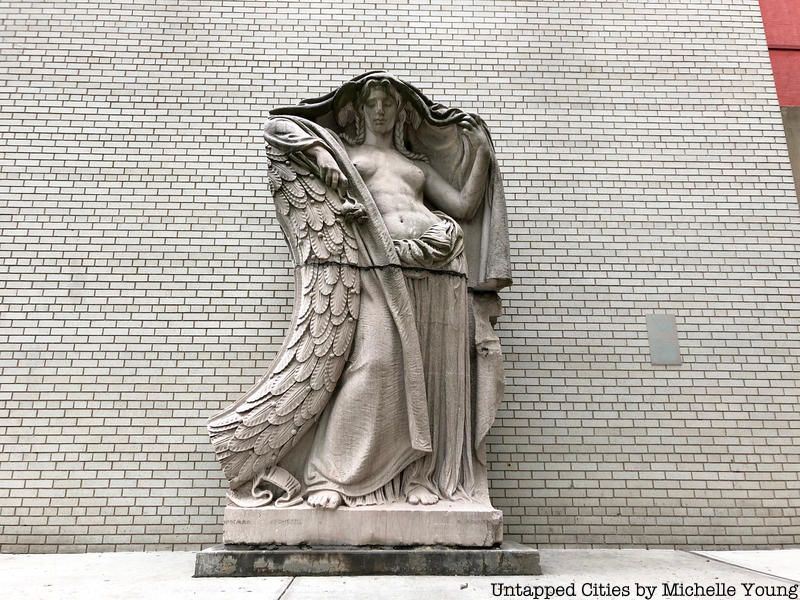
During the demolition of the original Penn Station, many enormous granite pieces from the station were simply dumped into the New Jersey Meadowlands and other places. The twenty-two eagles, sculpted by Adolph A. Weinman, that flanked the four “Day and Night” clocks were sent to new homes throughout the country, with two remaining at the current station. The clocks, which were located above each of the station’s four entrances, were less lucky – two were lost in the Meadowlands, one was sent to an Eagle Scout Memorial in Kansas City, and half of one was found in a Bronx recycling depot in the 1990s.
Fortunately for posterity, the Brooklyn Museum has two remnants of the original Penn Station: the “Night” half of a “Day and Night” sculpture, standing eleven feet tall, and a partial marble column from the waiting hall displayed in the Steinberg Family Sculpture Garden. The artifacts were recovered thanks to the efforts of the Anonymous Arts Recovery Society (AARS), a group of New York City creatives, led by influential New York gallery owner Ivan Karp. During the height of New York City’s urban renewal, the Society was dedicated to salvaging the remnants of historical nineteenth-century architecture.
Join us on an upcoming tour of the Remnants of Penn Station, where we track down dozens of remnants of the original station still inside and around the current station.
You can get an autographed copy directly from Untapped Cities shipped to you or picked up from our Brooklyn office or a non-autographed copy on Amazon.
Subscribe to our newsletter